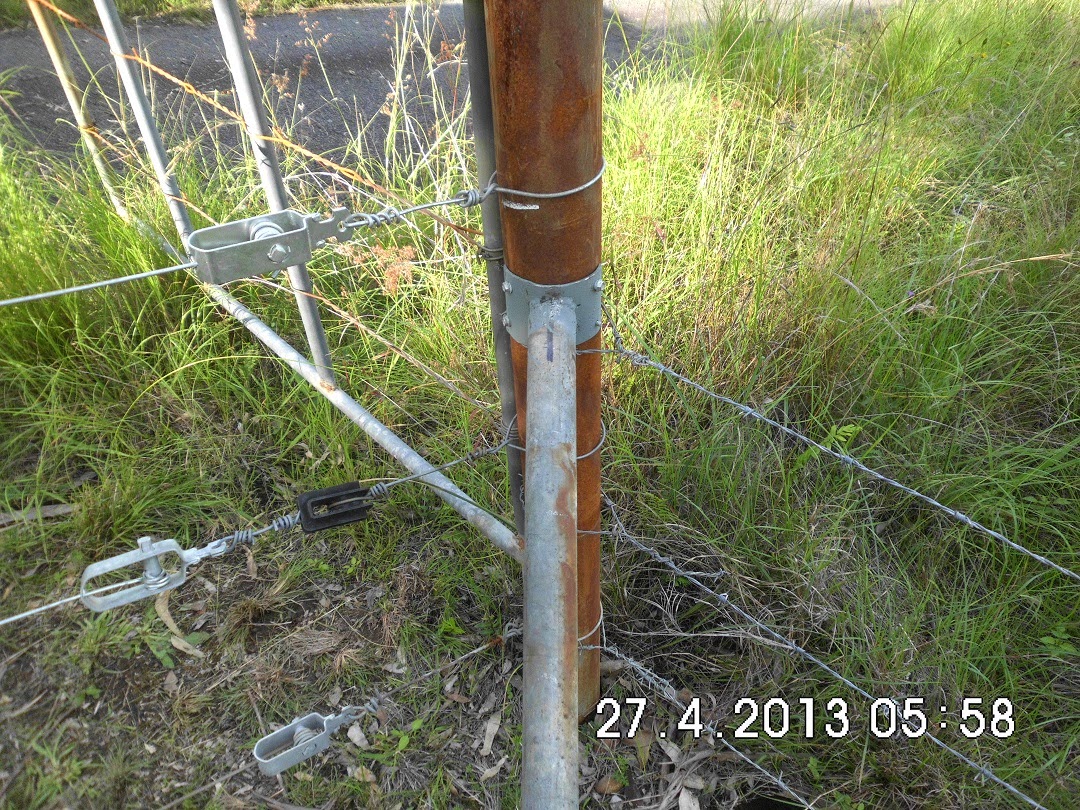Rather than dismantle the entire fence and start from scratch we decided to remove all the wire except for the top and bottom. Add steel post braces to all the wooden posts and put in two new wires. With a little effort we could make the top and middle wires capable of electrifying which would taking the animal pressure off the fence.
This patch up process would only take a couple of days and add another 10-15 years to the life of the fence with the only cost being labour and a couple of hundred metres of fencing wire.
 |
| Not much to salvage |
The first step was to put up a temporary electric fence to hold back the animals in the neighbours property while the repairs were undertaken.
 |
| A temporary fence to exclude the neighbours animals |
The top wire had been attached to the steel posts with tie wire and all these were cut off and insulators installed. Each end of the top wire was cut and Bullnoses installed and just before the connection was completed a host of poly pipe tubes slid onto the wire i.e. one for each wooden post. These tubes will insulate the wire from the wooden post.
 |
| Top wire and middle wire insulated for electrification |
The fence had been routed around a couple of trees in past, a really bad idea for any rural fence. Rather than redesign the entire fence we installed poly pipe sleeves to keep the wire off the trees. The problem with using live trees as part of a fence is the tree grows putting tension onto the fence. But the worst thing is the bark quickly rusts the wire. Our patch up should be good for a few years.
 |
| Protective sleeves to prevent corrosion |
 |
| Using a tree as a strainer is a bad idea but we can live with it for now |
The metal strainer at one end had no stay and one was retrofitted using some old galvanised pipe. The bracket was manufactured from a piece of pipe and expanded to fit the strainer. Four metal tek screws hold it in place. Fence tensioners are in place ready to tighten the wires.
 |
| Retrofitted stay |
The stay is concreted into the ground but before the concrete is poured a number of steel star picket off cuts are hammered into the hole to provide reinforcement. Once the concrete has set in a few days the fence will be tightened using the tensioners.
The positioning of the stay and how it is embedded in the ground are critical. When a strainer has tension from two directions a single stay must be located at the mid point. Using two stays i.e. one for each strain direction will result in the strainer eventually tipping. A pure physics issue.
The quality of the embedding is critical to keeping the strainer upright. There are various solutions. Some fencers use large flat plates of wood or metal to increase the surface area that the stay presses against. Others drive a wooden post deep into the ground for the stay to rest against. In our shallow soil some old star picket offcuts hammered as deeply as possible and concreted to the stay have proved reliable.
 |
| Concreted Stay base |
The last thing that was added was a simple switch for the neighbours to allow them to easily turn off the electricity to the boundary. It is clearly marked with a bright Orange sign made from recycled plastic.
This is not the prettiest fence but it is robust and the electrification will keep the animals from using it as a scratching area and provide some longevity.
No comments:
Post a Comment